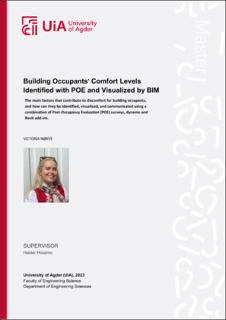| dc.description.abstract | Creating and maintaining a comfortable indoor environment is crucial for energy-efficient building operation. However, there is often a disparity between defined comfort conditions and occupants' perceived comfort. To address this, collecting occupants' feedback and evaluating building performance through post-occupancy evaluation (POE) surveys are essential. Building Information Modeling (BIM) can enhance the visualization of survey results by providing a digital representation of the building.
This study aimed to utilize POE surveys, Dynamo, and Revit add-ins to identify, visualize, and communicate factors contributing to discomfort for building occupants. A POE survey was conducted with 51 respondents, assessing aspects such as temperature comfort, indoor air quality, visual comfort, acoustic comfort, and space adequacy. Results indicated that occupants were most dissatisfied with indoor air quality in summer and most satisfied with space adequacy.
Dynamo, a visual programming tool, was employed to create a script that imported the survey results into each room, colorizing them based on the survey aspects. Additionally, Revit add-ins were developed using Microsoft Visual Studio and the C# programming language to import and present data from Excel files within the Revit model. This facilitated the visualization of sensor data in the same BIM environment.
By conducting the POE survey, comfort levels were identified, and Dynamo scripts colorized the rooms in Revit to represent the comfort levels. The Revit add-ins further enhanced BIM's role as a unified and digital database, allowing the import and reading of sensor data.
In summary, this research aimed to use POE surveys, Dynamo, and Revit add-ins to identify, visualize, and communicate factors contributing to discomfort for building occupants. The combination of these tools provided valuable insights into comfort levels and facilitated efficient visualization and communication of survey results within the digital building model. | |
